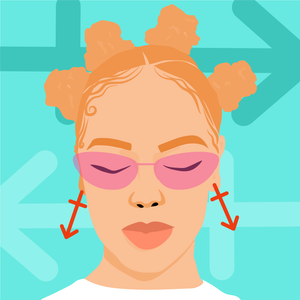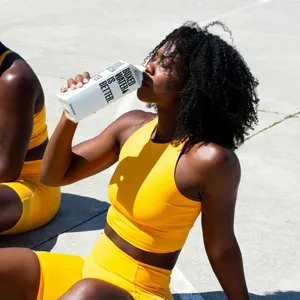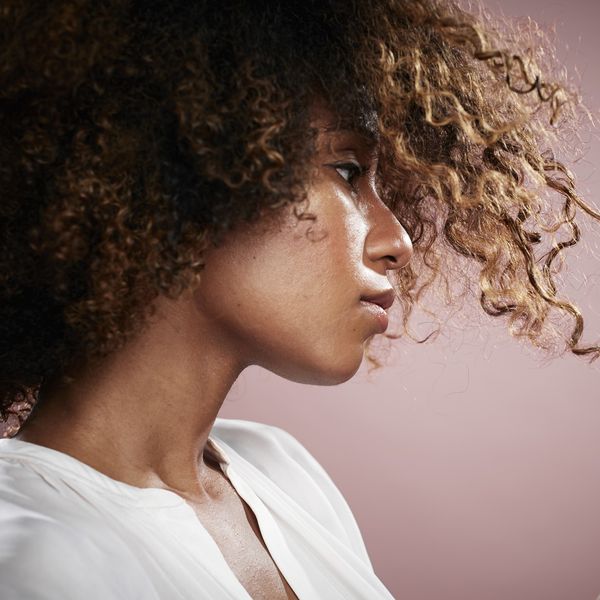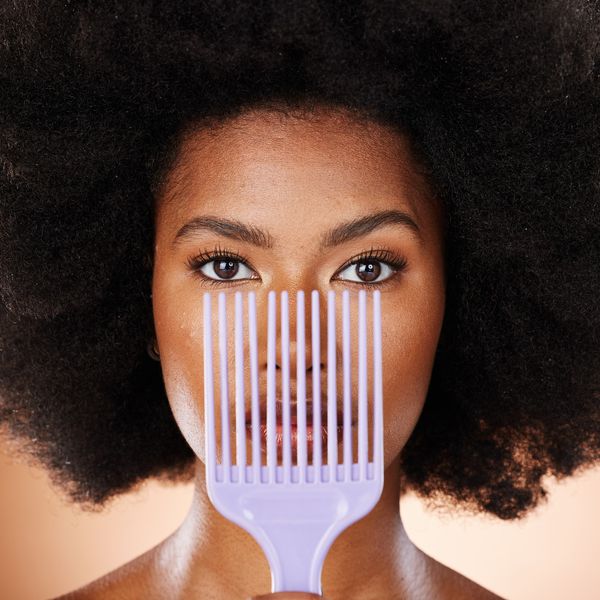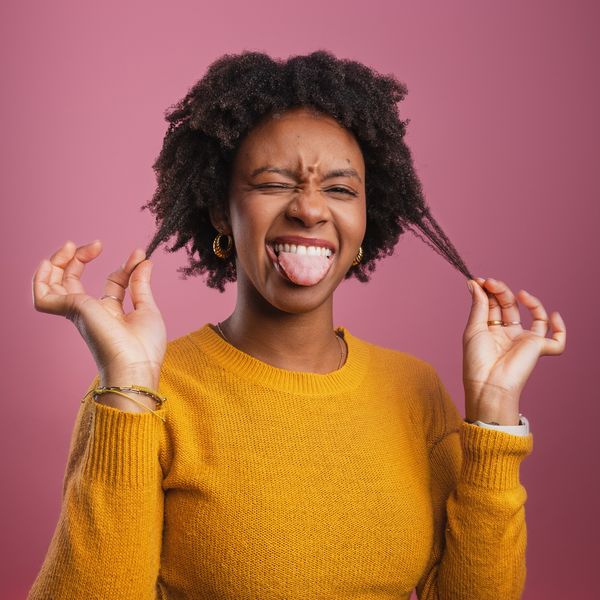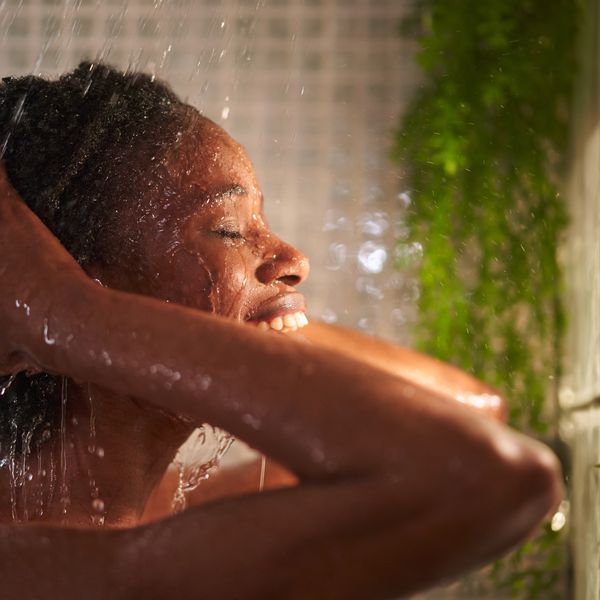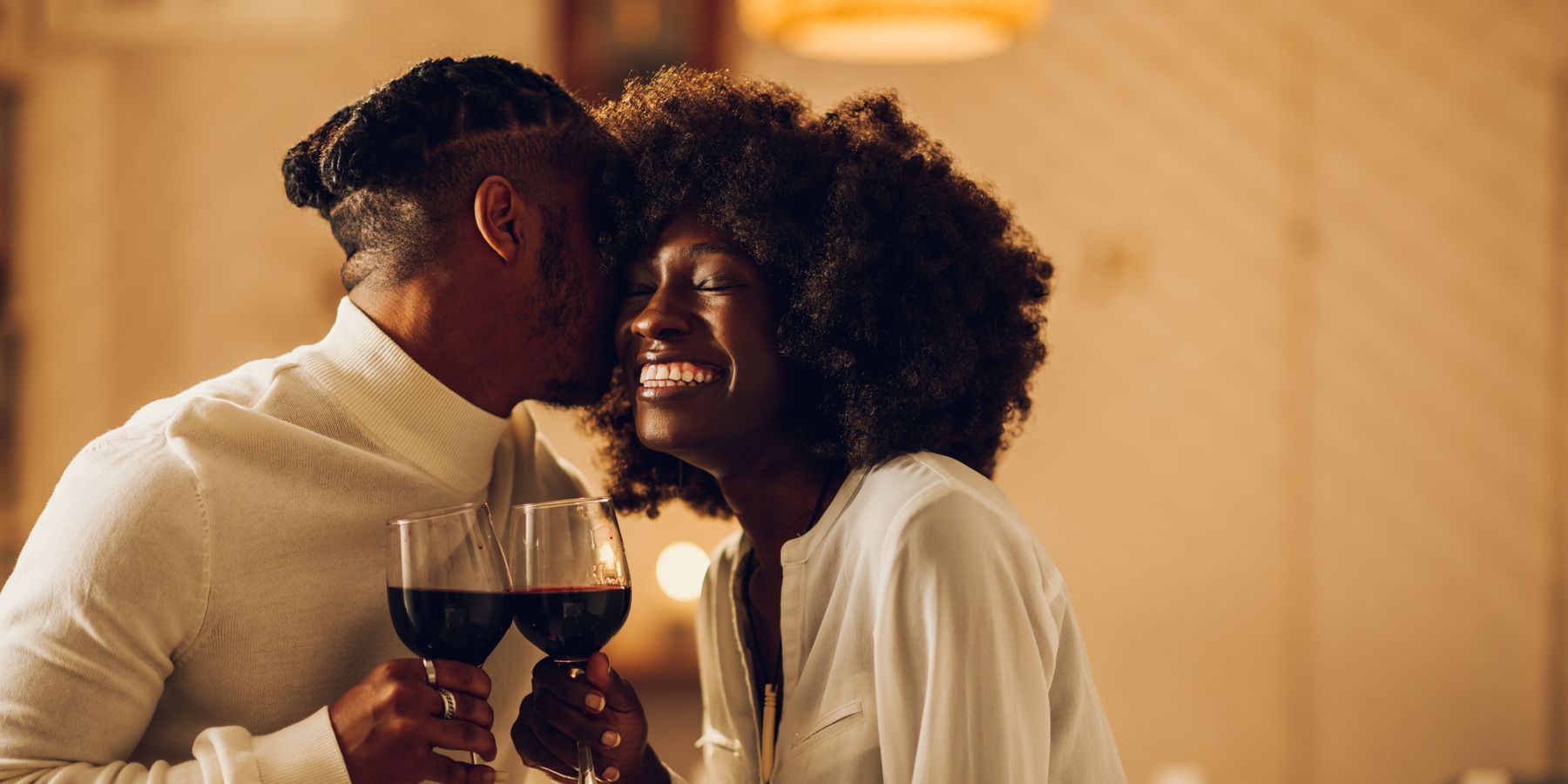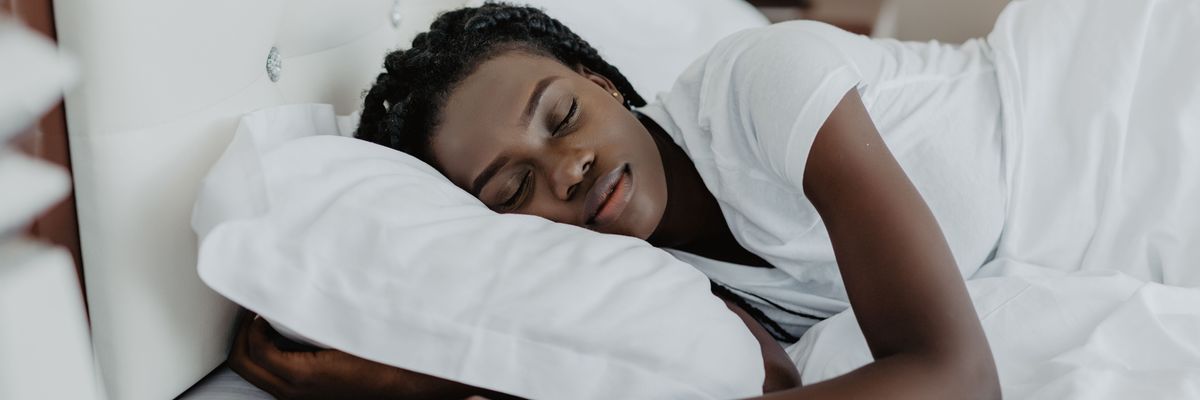
OK, I don't know about y'all, but as someone who personally likes to rock an Afro, more than just a lil' bit, I've had a hard time finding articles that are specifically dedicated to styling that powerful natural hairstyle. It's like there are plenty of pieces of how to handle Afro-textured hair yet not ones on how to just let your Afro glow in all of its Blackness and glory.
A wise person once said that if you don't see a solution to a problem, maybe you should be the one to create it. Indeed. INDEED. That's what I'm about to be on today. For the record, in order for your hair to qualify as a bona fide Afro, you need a good 3-5 inches of natural hair on your head to start (shorter than that is a TWA which stands for a "Teeny Weeny Afro"). But if you've got that and you're ready to wear your hair out more often than you currently do, I've got some tips on how to care for and style your Afro, so that you will be the focal point of everyone you come into contact with (because we all know that Afros tend to have that effect on folks!).
1. Definitely Do Some Pre-Pooing
There are a few reasons why I'm such a fan of the pre-pooing process. For one thing, it helps to bring some additional moisture to my hair so that the shampooing process doesn't result in my tresses becoming drier than I want/need them to be. Another thing I like about pre-pooing is it helps to add some "slip" to my locks so that there's less detangling that I need to do, both before and after washing and conditioning my hair. One more thing that's cool about pre-pooing is it can actually make my conditioner even more effective which is really important since I want my hair to be as shiny, soft and manageable as possible.
If you've never pre-pooed before, all you're basically doing is applying an oil, butter or both to your hair before you actually wash it. Simply separate your hair into 4-8 sections (depending on how long and thick your hair is). Then apply a generous amount of an oil like olive oil (which is loaded with antioxidants), jojoba (it deeply moisturizes and soothes dandruff) or sweet almond oil (it helps to seal your hair's cuticles) or a butter like shea butter (it contains vitamins A and E) or mango butter (it helps to reduce breakage) and allow it to sit on your hair for 30-45 minutes. Then shampoo and condition your hair as usual, making sure to thoroughly rinse your hair with lukewarm water before beginning the shampooing process. I can assure you that you'll notice a difference if you do this.
2. Shampoo Your Hair with Some Black Soap
An Afro just ain't right if it's not super soft. That's why it's so important to avoid using any shampoos that have sulfates in them. The reason why is because sulfates have a tendency to really dry your hair out. So, unless you're looking to remove a lot of "gunk" from your hair, steer clear of that kind of shampoo and go with something that is sulfate-free. As far as brands go, one that I've recently come to like is a Black-owned hair and skin care brand called Alaffia. They've got an all-in-one African black soap line that's pretty dope. One, because you can use it all over your hair and body. Two, because it comes with different additions to it like tea tree and mint, honey and lavender (to start).
Anyway, black soap is great for your hair because it's high in vitamins A and E, antioxidants, potassium and magnesium. As a result, it's the kind of soap that is able to feed your hair's follicles, help to define your hair's natural curl pattern, soften your hair and also deeply cleanse your scalp without drying your hair out in the process.
A lot of us are always looking for some high-end shampoo brand to treat our hair when something as simple as black soap can be all that our hair really and truly needs.
3. Deep Condition It
Back when I was only semi-serious about growing my hair out, I would slap some conditioner on my hair, let it sit for five minutes tops, rinse it out and go on about my styling way. Yeah, that was definitely working against me because, since most of us have a much tighter curl pattern than women of other ethnicities, it's difficult for the natural sebum from our scalp to get all the way down our hair shaft. Deep conditioning helps to compensate for this fact. Not only that but it helps to restore our hair's natural pH balance, can make our hair way more manageable, it strengthens our hair and it makes our hair more elastic too (which makes it so much easier to style).
As far as the deep conditioning process goes, it's a good idea to apply the product of your choice to your hair right after shampooing it. Make sure to leave it on for no less than 30 minutes (honestly, a couple of hours is pretty ideal). Then rinse with cool water to seal your cuticles back. And what deep conditioners should you use? I personally go with about any brand and then add some Chebe powder to it (you can read more about what makes Chebe so awesome by checking out "Uncommon (But Totally Natural) Things That Are Great For Hair Growth"). Sometimes I leave the conditioner on for two hours; sometimes I wrap my hair up and leave it on overnight. As far as specific conditioners that can do wonders for your locks, our site has the articles "8 Hair Masks & Deep Conditioners That Revitalize Dry, Damaged Hair" and "5 Deep Conditioners Your Curls Deserve" that can help to point you into the right direction.
4. Also, Use a Leave-in Conditioner
It might seem a little redundant to follow-up deep conditioning with a recommendation to also apply a leave-in conditioner but chile, ever since I've added this extra step, my hair has not been the same—in the best way possible! Because moisture is something that our hair can always benefit from, a leave-in conditioner can help to give your hair that extra bit of "umph" that it needs to avoid becoming dry and brittle in between wash days. Something else that I really like about it is, it makes styling my hair so much easier to do, plus it reduces frizz and also helps to define my natural curls.
Although there are plenty of leave-in brands on the market, my personal go-to leave in is Aunt Jackie's Quench – Moisture Intensive Leave-In Conditioner because the slip is amazing and the moisture lasts for literally days on end. When it comes to leave-ins, another route that you can take is making your own. It's really not as hard as you might think. If you'd like to give it a shot, Kinky Curly Yaki has an article that features 14 DIY recipes. You can check it out here.
5. Try to Not Permanently Dye Your Hair
As someone who used to permanently dye my hair, almost about as often as I changed my clothes, I get how much fun it can be to switch up your hair color on a dime. You can still do that—just opt for going with a semi-permanent dye, some hair color wax or a natural hair highlight option (like a coffee rinse or cranberry juice rinse). The reason why permanent dye is bad for your hair is 1) it contains ammonia that definitely dries your hair out and 2) stripping the melanin from your hair and then adding the ammonia to it causes your hair cuticles to swell which can damage your hair over time.
The woman who currently holds the title in the Guinness Book of World Records for having the largest Afro is a woman by the name of Aevin Dugas. Her hair currently sits at a whopping 9.45 inches tall, 9.84 inches wide and 5.15 feet in circumference. I'm pretty sure she would cosign that color is cool—permanent dye is absolutely not.
I'm very much aware of the fact that some of us get frustrated with our lack of length retention and immediately chalk it up to our hair isn't growing. Listen, as long as you're alive (and you don't have some sort of hair condition like alopecia), your hair is always growing. Problem is, you might not be seeing inches because the damage is happening at the same rate as the growth, though. Color can be a culprit when it comes to that. That's why you should chill out from using it.
6. Braid Up and Air Dry
When it comes to this particular tip, I'll just put it right on out there and say that I am definitely a fan of blowing my hair dry on my wash days. Although a lot of people in the natural hair community say that heat is an absolute no-no, I personally don't agree. Stretching my hair out this way has actually helped me to gain more inches because there is less pulling, tugging and fairy knots. Now what I will say is, based on what your hair type is, sometimes blow drying can make your hair look straighter than you would like for it to be when you want to wear an Afro. This could be a good reason to leave your blow dryer alone.
If you want your Afro to have some of the texture and bounce that typically comes with having one, it's actually best to dry your hair with a T-shirt (to safely sop up excess moisture), coat your hair with a butter like shea butter (you might want to seal your ends too with the help of some Jamaican Black castor oil) and then section it all out and braid it. You can cornrow it or braid your hair down into plaits. Let it completely hair dry (this can take a day or two depending on length and volume) and then take your braids out and use your fingers or an Afro pick to style your locks (more on that in a sec). Doing it this way can help your hair to have "spring" to it which is ideal when wearing an Afro.
7. Follow the Right Afro Pick Rules
When it comes to actually styling your Afro, something that isn't brought up nearly enough is you can wear it picked out so that it's stretched and tall in all of its natural glory or you can use your fingers to give it more of a texturized look.
The benefits of the latter option is you significantly lower the risk of damaging your hair because so long as you move slowly and gently—and you add a bit of oil on your fingers to give your hair some slip—you don't have to worry about the pulling and snagging that styling tools can sometimes do. As far as Afro picks go, they're pretty awesome when it comes to making your Afro as big as possible, so long as you use them correctly.
And just what does that mean? Definitely use picks on dry hair (if you need help to manage through your hair when it's wet or damp, go with a very wide-toothed comb). While holding your hair, in sections I might add, start from the ends and work your way up to the roots if you want maximum volume. If you'd prefer to keep your textured look but you still want some height, use your comb to gently lift the roots of your hair up only. For some additional tips on how to pick your Afro correctly, I really dug a how-to video by a woman by the name of Alexus Crown (who has a really dope Afro in it!). You can check it out here.8. Trim Semi-Regularly
By far, one of my all-time favorite Afros is featured in a story that I did last year that I had no idea so many of y'all would be interested in. Any of you remember "Looking For Hair Growth? It Might Be Time To Bring 'Blue Magic' Back"? Whew-whee! Anyway, when you take a look at EfikZara's hair, you kind of get the impression that she's not following the standard "trim every 4-6 weeks" rule. Honestly, when you're trying to grow out an Afro, it's not really a necessary thing to do. So long as you follow all of the other tips mentioned in this piece, you should be able to go every 8-12 weeks; especially if you're gonna rock a textured 'fro, more times than not. The main thing you need to aim for is an Afro that isn't top-heavy, is pretty symmetrical and isn't frizz city (which can be a sign of split ends or excessive damage) all over your head.
As far as the trimming process goes, some folks prefer to plait their hair and dust their ends while others prefer to pick their Afro all the way out and run some clippers over the ends of it. By the way, you can also always go to a professional stylist too. Bottom line, there's no need to go scissor happy; especially if you wanna see real progress. Just make sure that your Afro looks tight 'n right.
9. Use Satin or Silk Hair Ties Only
If you're going to wear your hair in a protective style during the week and your Afro on the weekends, this point doesn't really apply all that much. But if you're someone who wants to wear your natural tresses out most of the time, in order to protect your hair from the weather, invest in some satin or silk hair ties. They are perfect for pulling your hair into a big 'ole Afro puff or even just keeping in your purse if you want to pull your hair back off of your face, every once in a while. The reason why the ties need to be made out of satin or silk material is because they are less prone to creating friction on your tresses or drying your hair out.
10. Braid It Up at Night
In order for your soul to glow in all of its glory, it's important that your hair remains as stretched as possible. That said, you don't want to rely on applying heat on the daily because that could lead to breakage. You also shouldn't just tie it up at night because your body temperature tends to shift as you sleep and the sweating could lead to shrinkage. The solution? Braid your hair into plaits (or cornrows if it's still kind of short) before turning in. It will keep your tresses stretched, protect your ends and give your hair a little more texture if the finger-styling route is how you prefer to go.
11. Oil the Parted Spaces Before Tying It All Up
Your hair grows from the roots. At the same time, if you want to maintain length, you've got to focus on your ends. While braiding your hair up at night can help to protect your ends from the friction that comes with tossing and turning all night long, oiling your scalp can help to feed your hair follicles. When it comes to the kind of essential oils that can increase blood circulation and stimulate your hair follicles, some of those include cedarwood, clary sage and peppermint. My two cents would be to mix these up with a carrier oil of some type.
Tropic Isle Living features oils that I like because the bottle has a nozzle that makes the oil easy to apply. You can choose from all kinds including black seed, sweet almond, sunflower, olive, argan, Cerasee and black walnut. If you heat up the oil for a couple of seconds in your microwave beforehand, it can be a super soothing and relaxing treat for your scalp.
12. Make Your Own Bonnet
Here's a true confession. I don't always like to tie my hair up at night. I just don't. What has convinced me to do it more often is that fact that just braiding my hair alone doesn't necessarily or automatically protect it from breakage because moving around at night can still cause friction, dryness and breakage to any of the strands that come loose. So yeah, while a satin pillowcase is cool, if you know that you're someone whose head isn't going to stay on it all night long, you really do need a satin scarf or bonnet to keep your tresses protected. There are dozens of bonnets on the market. Or, if you want, you can always make yourself one. I checked out some pretty easy DIY YouTube videos. Take a stab at it by going here, here, here, here or here.
Welp. There you have it. A few things that can help you to put forth your very best Afro. If you've got one, please don't hesitate to show off in the comments. There is nothing like a Black woman in all of her crowning glory. For me, an Afro hairstyle tops the list.
Join our xoTribe, an exclusive community dedicated to YOU and your stories and all things xoNecole. Be a part of a growing community of women from all over the world who come together to uplift, inspire, and inform each other on all things related to the glow up.
Featured image by Shutterstock
- Black Women With Buzz Cuts - xoNecole: Women's Interest, Love ... ›
- Adding Head Wraps To Your Hair Routine Is The Ultimate Protective ... ›
- Pass The CROWN: Why This Exec Is On A Mission To End Black ... ›
- What Is The Crown Act? - xoNecole: Women's Interest, Love, Wellness, Beauty ›
- Pattern Beauty Blow Dryer Review Tracee Ellis Ross - xoNecole: Women's Interest, Love, Wellness, Beauty ›
- Best Spring Hair Care Tips: Guide To Hair Health Growth - xoNecole ›
This Is How To Keep 'Holiday Season Stress' From Infecting Your Relationship
Hmph. Maybe it’s just me, but it seems like there is something really weird happening in the fall season air (because winter doesn’t officially begin until December 21) that cuddle season is in full swing while break-up season is as well. In fact, did you know that break-ups are so popular during the holiday season that December 11 is deemed Break-Up Day?
The reasons why relationships shift around this time vary; however, I did both roll my eyes and chuckle when I read that a very popular one is because it’s an easy way to get out of getting one’s significant other a Christmas present. SMDH.
Anyway, I personally think that the less shallow folks out here may contemplate calling things “quits” or they at least distance themselves a bit from their partner (and what I’m referring to is serious relationships) due to all of the stress and strain that oftentimes comes with the holidays whether it be financial, familial, due to their tight schedules or something else.
Listen, I would hate for you and your man to miss the fun and happiness of experiencing this time of year, all because you are so overwhelmed or irritated that you can’t really enjoy it. That’s why I have a few practical tips for how to avoid allowing the typical holiday season stress from INFECTING your relationship.
Manage Your Expectations
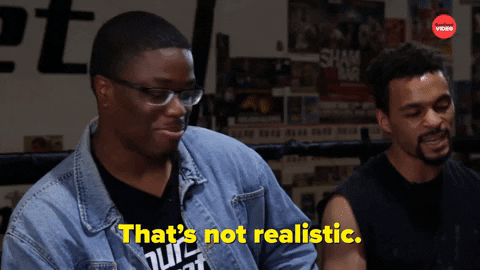 Giphy
GiphyUnmanaged expectations. If there is a main reason why the holiday season tends to be so stress-filled for so many people, I’d bet good money that this is the cause. And when you’re in a long-term relationship, expectations can manifest themselves in all sorts of cryptic and/or unexpected ways. You might have relatives who assume that you are going to be with them for Thanksgiving or Christmas when you have other plans in mind. You might be thinking that you are going to spend one amount for presents while your man is thinking something totally different. When it comes to scheduling, your signals may be crossed.
And you know what? To all of these scenarios, this is where clear and consistent communication come in. Don’t assume anything. Don’t dictate anything either. From now until New Year’s, mutually decide to check in once a week, just to make sure that you are both on the same page as it relates to the holidays and what you both are thinking will come along with it. The less blindsided you both feel, the less stressed out you will be. Trust me on this.
Set (and Keep) a Budget
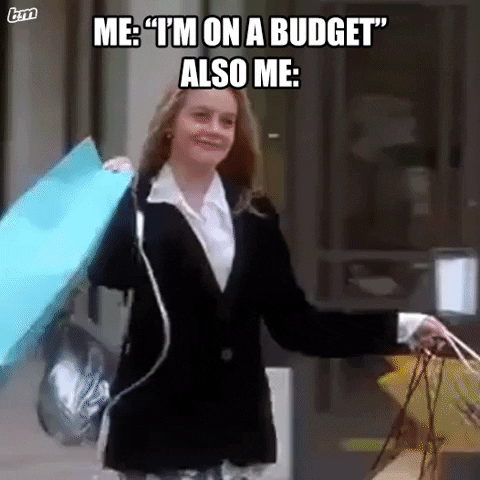 Giphy
GiphyOkay, so I read that last year, 36 percent of Americans incurred some type of holiday-related debt. Hmph. Last year, there was still some sense of normalcy in this country, chile, so I can only imagine what finances are gonna look like over the next several weeks. That said, since I don’t know a lot of people who don’t find being broke stressful, make sure that you and your bae set a budget and then stick to it this year — no ifs, ands or buts.
Because really, y’all — it doesn’t make sense to deplete savings and/or max out credit cards for a few days of giggles only to be damn near losing your mind because you don’t know how to make ends meet come Dr. Martin Luther King, Jr. Day.
And by the way, this tip doesn’t just speak to things like food and gifts; I also mean travel. If it doesn’t make a ton of sense (or cents) to be all over the place this year — DON’T BE.
Keep Matthew 5:37 at the Forefront
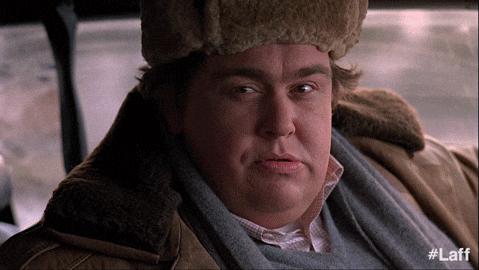 Giphy
GiphyIf off the top of your head, you don’t know what Matthew 5:37 says, no worries, here ya go: “But let your ‘Yes’ be ‘Yes,’ and your ‘No,’ ‘No.’ For whatever is more than these is from the evil one.” That verse right there? Oh, it’s a boundaries lifesaver! I say that because do you see “maybe” or “I’ll think about it” in there? Nope. LOL. It says that you should tell people “yes” or “no” and leave it at that — and that complements Anne Lamott’s quote, “’No’ is a complete sentence” impeccably well. Yeah, you’ve got to remember that anything beyond a yes or no to a request is privileged information; you don’t owe anyone details or an explanation.
Besides, if you are really honest with yourself, when someone asks you something and you give a “Umm, let me think about it” kind of reply, more times than not, you already know what your answer is going to be — so why not let you both off of the hook? Give your response. Commit to that. And let everyone (including yourself) get on with their lives and schedules.
I promise you that when it comes to those holiday parties, you are pissing more folks off by not RSVP’ing or doing so and not showing up than just saying, “Thank you but not this year” off the rip.
Remember That Your Personal Space Is Privilege Not a Right
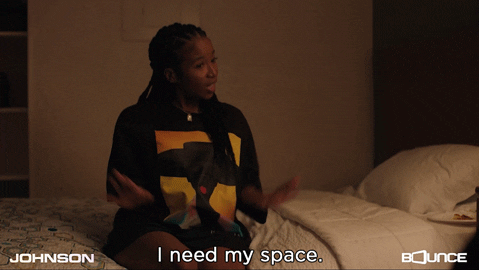 Giphy
GiphyA friend of mine recently bought a new house and invited me over to come see it. He’s a single man with no children, so as I was taking in all of the space that he had, especially as I walked through his finished basement, I joked about relatives coming to live with him. “Hell no” and “absolutely not” were pretty much his immediate responses as he went on to say that some folks even had the nerve to be offended when he told them that he had no intentions on taking DNA in.
Ain’t it wild how people think that your stuff is their right? And yes, that brings me to my next point. Your home is your sanctuary space. If you want to host folks this year — cool. If not, ALSO COOL. Please don’t let folks (family included) guilt you into how they want you to act or even into what they would do if the shoe was on the other foot. You are not them — and as one of my favorite quotes states, “If two people were exactly alike, one of them would be unnecessary.” (A man by the name Larry Dixon said that.)
Hell, my friends? They know that I am good for sending them random things that they need or even want all throughout the year. Coming over to hang out at my pace, though. Uh-uh. Chalk it up to being a card-carrying member of the ambivert club yet I like keeping my living space personal — and I sleep like a baby, each and every night, for feeling that way.
Always remember that your space, your time, your resources, your energy and shoot, yourself period (including your relationship), are all things that are your own. You get to choose how, when and why you want to share them. The holiday season is certainly no exception.
Cultivate Some “You Two Only” Traditions
 Giphy
GiphyIt’s not uncommon for some couples to hit me up after the holiday season to “detox.” Sometimes it’s due to the financial drama (and sometimes trauma) that they experienced. Sometimes it’s because they allowed their relatives (especially in-laws) to get more into their personal business than they should’ve. More than anything, though, it tends to be because they didn’t get enough quality time together and so ended up feeling “disconnected.”
Please don’t let that happen. Listen, I’m not even a holidays kind of woman and yet, I will absolutely sit myself down with some hot chocolate and chocolate chip cookies to enjoy a Hallmark holiday film or two. Aside from the fact that most of them are lighthearted and sweet, I also like that they usually focus on couples loving on each other amidst all of the holiday beauty and ambiance — which is something that all couples should set aside some time to do.
Maybe it’s a vacation. Maybe it’s a staycation. Or maybe it’s my personal favorite, A SEXCATION. Whether it’s for a few days, the weekend or even overnight — don’t you let the holidays go by without setting aside time for you and your man to celebrate one another. Don’t you dare (check out “Are You Ready To Have Some Very Merry 'Christmas Sex'?”).
GET. SOME. REST.
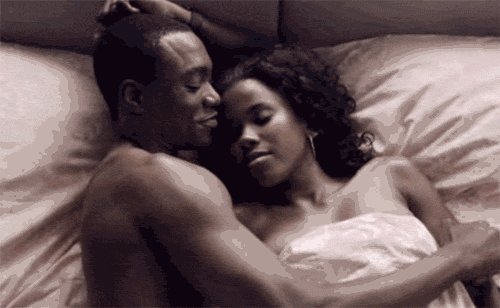 Giphy
GiphyI once read that 8 out of 10 people get stressed out over the holidays and 3 out of 10 lose sleep during to it — and when you’re stress-filled and sleep-deprived, that can absolutely lead to hypersensitivity, making mountains out of molehills and even not being in the mood for sex.
Your relationship can’t afford to go through any of this, so definitely make sure to prioritize rest. I don’t care how unrealistic it might seem during this time, sleep should never be seen as a luxury; it will always and forever be a great necessity.
That said, try to get no less than six hours of shut-eye in (check out “6 Fascinating Ways Sex And Sleep Definitely Go Hand In Hand”) and even ask your bae to take a nap with you sometimes (check out “Wanna Have Some Next-Level Sex? Take A Nap, Sis.”). Not only will sleep help to restore your mind, body and spirit but, when it’s with your partner, it’s an act of intimacy that can make you both feel super connected, even in the midst of what might feel like chaos.
___
Holiday season stress is real. Still, never give it the permission or power to throw your relationship off. Put you and your man first and let the holidays be what they are gonna be, chile.
Let’s make things inbox official! Sign up for the xoNecole newsletter for love, wellness, career, and exclusive content delivered straight to your inbox.
Featured image by Shutterstock
While doing a podcast interview a couple of weeks ago, when I said my age, the interviewer complimented me by saying that what I said is not what they would’ve guessed. When they asked what the secret was, the first thing that came out of my mouth was, “Oh, I’m gonna take me a nap.”
I adore sleep. I’ve said before that it’s like what Six Flags is to some people. And really, it’s just a plus that there are so many health benefits from getting plenty of rest. Beauty-wise, science does reveal that getting no less than seven hours a night can slow down signs of aging. Know what else? There are some direct things that sleep — and the lack thereof — can do to your immunity as well.
And so, since this is the time of year when catching a cold (and/or the flu) is common, let’s talk about the impact that sleep (and again, a lack thereof) has on your immune system. That way, you can remain as healthy as possible during the fall and winter seasons.
1. Less Sleep Means More Colds
 Giphy
GiphyLike I stated in the intro, I’m pretty sure you’ve heard somewhere that the fall and winter are the seasons when people are most susceptible to catching a cold or coming down with the flu. And that’s exactly why I thought I would start this all off by sharing the fact that some studies reveal that if you get less than six hours of sleep, on a consistent basis, you end up making yourself more vulnerable to coming down with both. In fact, some research says that only 18 percent of people who get six-plus hours of rest caught a cold while almost 40 percent who got less than that did.
The logic behind it all is sleep gives your body time to build up the proteins and cells (like cytokines and T-cells) that you need to fight off certain viruses. So, if nothing bothers you more than having a stuffy nose or stubborn cough when it’s cold outside, getting more sleep is one way to prevent that from happening to you.
2. Less Sleep Means More Allergy Symptoms
 Giphy
GiphyAt the end of the day, an allergy is basically what transpires whenever your immune system “overreacts” to something that other people’s systems do not. And since sleep is what helps to keep your immune system nice and strong — well, I’m sure you get how less allergy-related symptoms and more sleep go hand in hand. Also, since sleep helps to decrease bodily inflammation (more on that in a bit) and inflammation can also intensify allergy symptoms, that’s just one more reason to get as much shut-eye as possible.
3. Less Sleep Means Potential Diabetes and Heart Disease
 Giphy
GiphyDid you know that in 2024, Black women were diagnosed with diabetes 24 percent more than any other adult demographic. Also, it continues to be a reality that heart disease is the leading cause of death for Black women. These two sobering statistics alone should be enough of an incentive to do whatever you can to keep the risk of diabetes and heart disease way down.
One way to do that is by getting more sleep. Aside from the fact that sleep strengthens your immune system to where it is easier for you to fight off illness and diseases, sleep can keep your blood sugar levels in a healthy space; plus, when it comes to your heart, it gives it, along with your arteries and blood vessels a break.
4. Less Sleep Means Less Time for Your Body to Push “Reset”
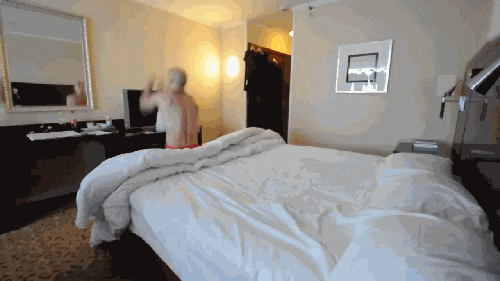 Giphy
GiphyIf you really stopped to consider all that your body goes through during the day (you can read some about that here), you definitely would respect it enough to do your best to thank it by giving it no less than six hours of sleep, each and every night. Sleep is what helps to slow your brain and body down so they are able to “refuel” for the next day. After all, how can your body prevent you from getting sick if your immune system is too worn out to fight ailments off? Exactly.
5. More Sleep Helps You to Fight Off Infections
 Giphy
GiphySpeaking of, in order for your body to fight off infections, there are certain cells and antibodies within you that need to be healthy and strong — one way that they get and stay that way is by you getting a good amount of sleep. For instance, remember when I touched on cytokines earlier? Well, the same way that they help to prevent colds, they also help to prevent infections too. And since sleep lowers your cortisol (stress) levels, rest gives your body the time and space to build up an army that can fight off free radicals and other health-related challenges while you are awake.
6. More Sleep Lowers Bodily Inflammation
 Giphy
GiphyWhenever a health-related issue is mentioned on this platform, inflammation is something that is mentioned quite a bit. Probably the easiest way to explain inflammation is it’s how your body responds/reacts whenever something is happening to your body that shouldn’t be, whether it’s an illness, an injury, a germ or something that you may be allergic to.
If you happen to have chronic inflammation, some symptoms that are associated with that include fatigue, stiff joints, skin rashes, weight gain and moodiness.
The interesting thing about all of this is if you aren’t getting enough rest, you could be triggering inflammation in your body. That’s because studies reveal that a lack of sleep can elevate molecules that are associated with inflammation. So, if you don’t want inflammation to increase within your system, you should definitely catch more zzz’s.
7. More Sleep Regulates Hormones
 Giphy
GiphyWhen it comes to hormones like serotonin, estrogen and cortisol, believe it or not, they play a role in how your immune system acts and overreacts. That’s because, if your hormones are out of balance, that can cause your immune system to work harder than it actually should and that can make you more vulnerable to sickness. One way to keep your hormones leveled out? SLEEP.
That’s because sleep gives your body the opportunity to rest, repair and restore your hormone levels. On the other hand, when you are sleep deprived, that can put/keep your hormones on the ultimate roller coaster ride. #notgood
8. More Sleep Strengthens Vaccines
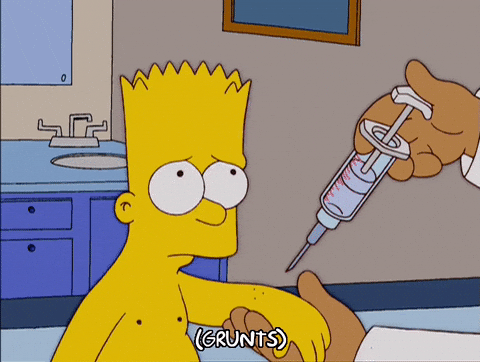 flu shot GIF - Find & Share on GIPHYGiphy
flu shot GIF - Find & Share on GIPHYGiphyIf you’re someone who is good for getting some sort of vaccine around this time of the year, make sure that you rest up before and after getting your shots. Not only does adequate rest before a vaccination help your immune system to be better receptive to your shots but sleep also helps your body to build up enough antibodies to make your vaccinations effective after getting them. Because if you’re gonna get pricked, shouldn’t it be worth it? My thoughts exactly.
Get some freakin’ sleep! Your immune system depends on it.
Let’s make things inbox official! Sign up for the xoNecole newsletter for love, wellness, career, and exclusive content delivered straight to your inbox.
Featured image by Shutterstock

